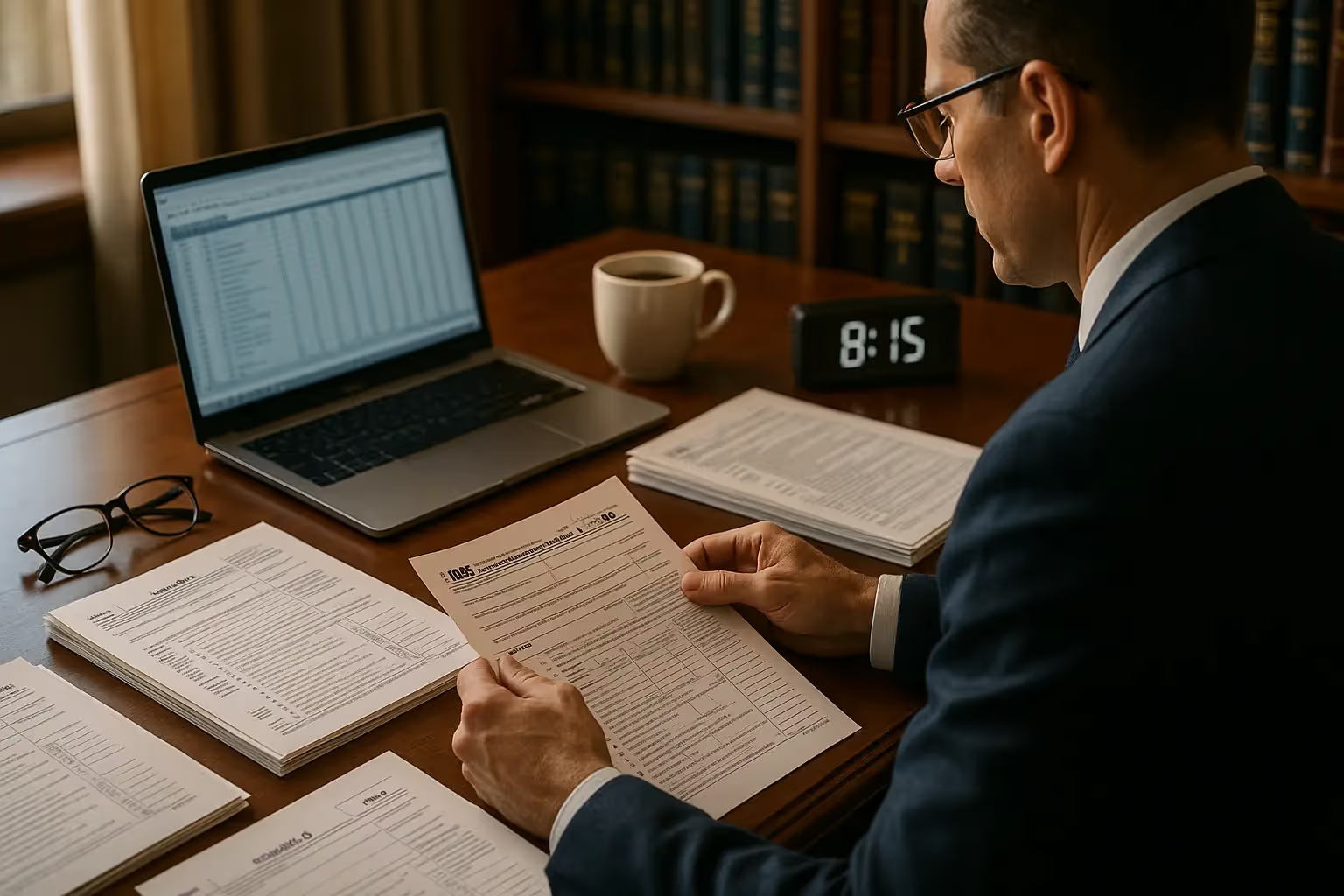Unfiled 2017 Form 941: How to File, Penalties, and Relief Options

Business owners who failed to file Form 941 for 2017 face significant tax complications requiring immediate attention. This IRS form is the primary tax form used to report federal income tax withheld, Social Security tax, and Medicare taxes from employee wages. It also accounts for the employer’s portion of FICA and other payroll taxes. Missing these filing deadlines creates growing payroll tax liability, penalties, and potential personal responsibility for unpaid taxes.
Unfiled employment tax deposits go far beyond late fees. The Internal Revenue Service treats payroll and income tax withholding as trust fund taxes, meaning employers may be held personally responsible if taxes withheld from employees’ paychecks remain unpaid. Whether wages include taxable Social Security tips, Medicare wages, or other compensation, failure to file quarterly returns leads to escalating penalties that compound until resolved.
This guide provides step-by-step instructions for filing an unfiled 2017 Form 941, calculating total tax liability, and understanding IRS updates on penalties and relief options. You will learn how to correctly report income taxes, handle additional Medicare tax withholding, and manage tax deposits. The article also covers when to use paper filing or electronic filing, how to address one or more quarters of missed returns, and when to seek help from a qualified tax professional to get back into compliance.
Understanding Form 941 and Its Importance
Form 941, the employer's quarterly federal tax return, is the cornerstone of business tax compliance for companies with employees. This IRS form requires employers to report income taxes withheld from employees' paychecks and Social Security and Medicare tax withholding amounts each quarter.
What Form 941 Reports
Form 941 captures several critical components of payroll tax liability that employers must track quarterly. The tax form requires employers to report the federal income tax withheld from their employees' wages over the three-month period. Additional elements include Social Security tax amounts for employer and employee portions, Medicare wages, and corresponding tax withholding.
- Federal income tax withholding: Amounts deducted from employees' paychecks for income tax purposes. This includes regular withholding plus any additional amounts requested by employees.
- FICA taxes: Combined Social Security and Medicare taxes totaling 15.3 percent of taxable wages. Employers and employees each pay half of this amount on wages paid to workers.
- Additional Medicare tax: Extra 0.9 percent tax on employee wages exceeding $200,000 annually. Only employees pay this additional Medicare tax, not the employer's share.
- Employment tax deposits: Quarterly reconciliation of tax payments made throughout the filing period. Most employers must make these deposits monthly or semiweekly based on their lookback period.
Why Employers Must File Quarterly
The IRS requires most businesses to file Form 941 every quarter to ensure the timely collection of employment taxes. This quarterly schedule allows the government to monitor payroll tax compliance and catch issues before they become major problems. Missing filing deadlines creates immediate penalties that accumulate rapidly. Seasonal employers and agricultural employees may have different requirements, but most businesses must submit returns by specific due dates.
Consequences of Failing to File on Time
Late filing triggers multiple penalty structures that can quickly exceed the original tax liability. The failure-to-file penalty starts at five percent of unpaid monthly taxes and reaches a maximum of 25 percent. Interest charges compound daily on unpaid taxes and penalties from the original due date.
- Trust Fund Recovery Penalty: Personal liability assessment against business owners for unpaid payroll taxes. This penalty amounts to 100 percent of the federal income tax that was withheld, in addition to the employee portions of Social Security and Medicare taxes.
- Business closure risks: Persistent non-compliance can result in forced business closure and asset seizure. The IRS has broad collection powers for employment tax debt, including bank levies and property seizures.
Step-by-Step Process for Filing an Unfiled 2017 Form 941
Filing your unfiled 2017 Form 941 requires careful preparation and attention to detail since you are working with historical payroll data. The process becomes more complex when dealing with older returns because you must use the correct tax rates and wage bases applied during 2017.
Step 1: Gather Required Documentation
Successful completion of your unfiled 2017 Form 941 depends on assembling complete and accurate payroll records from that tax year. You will need employee wage information, tax withholding records, and documentation of any employment tax deposits made during each quarter. Start by collecting payroll registers, bank statements, and copies of Forms W-2 issued to employees for 2017 to establish your total wages and tax withholding amounts.
Step 2: Obtain the Correct 2017 Form 941
Using the proper version of Form 941 is essential because tax rates and wage bases change annually. The 2017 version contains specific tax rates, including Social Security tax at 6.2 percent each for employer and employee on wages up to $127,200, plus Medicare taxes at 1.45 percent each with no wage limit. Download the 2017 Form 941 and instructions from the IRS prior year forms section at IRS.gov, or request paper copies by calling the IRS Forms Order Line at 1-800-829-3676.
Step 3: Complete Form 941 Line by Line
Begin with Part 1, which asks for the number of employees and total wages paid during the quarter. Report wages subject to federal income tax withholding in the appropriate sections, then calculate Social Security and Medicare tax amounts using 2017 rates. Line 3 requires the total federal income tax withheld from employee wages, while lines 5a through 5e capture taxable social security wages, taxable social security tips, Medicare wages, and additional Medicare tax withholding for high earners.
Step 4: Calculate Penalties and Interest
Add applicable adjustments for sick pay, tips, or other compensation items that affect your quarterly tax liability. Calculate your total tax amount by combining federal income tax withheld, Social Security taxes, and Medicare taxes for both employer and employee portions. Subtract any employment tax deposits made during the quarter to determine your balance due, then add failure-to-file penalties, failure-to-pay penalties, and daily compounding interest from the original due date.
Step 5: Sign and Submit the Return
Complete the signature section with an authorized person such as the business owner, corporate officer, or designated agent who has the authority to sign tax returns. Include your title and the date signed under the penalties of perjury certification. Mail the completed return to the appropriate IRS processing center based on your business location, using the addresses specified in your state's 2017 Form 941 instructions.
IRS Penalties and Interest for Unfiled Form 941
Understanding the penalty structure for unfiled Form 941 returns helps you calculate your total liability and evaluate resolution options. The IRS imposes multiple penalties that can significantly increase your original tax debt when returns remain unfiled for extended periods.
Failure to File Penalty
The failure-to-file penalty accumulates at five percent of unpaid taxes for each month or partial month in which your return remains unfiled. This penalty reaches its maximum of 25 percent after five months, meaning your 2017 returns have likely incurred the full penalty amount. The penalty applies separately to each unfiled quarter, so missing all four 2017 quarters results in maximum penalties on each return.
Failure to Pay Penalty
Separate from filing penalties, the failure-to-pay penalty charges 0.5 percent of unpaid taxes monthly, up to a maximum of 25 percent. This penalty begins accruing from the original due date until you pay the full tax liability. When failure-to-file and failure-to-pay penalties apply to the same period, the failure-to-file charge reduces to 4.5 percent per month to prevent double penalization.
Interest on Unpaid Taxes
Interest charges compound daily on unpaid taxes and penalties from the original due date of each return. The IRS sets interest rates quarterly based on federal short-term rates plus three percentage points for individual and business taxpayers. Interest cannot be abated unless the underlying penalty generating the interest is removed or the IRS made an error causing unreasonable delays.
Failure to Deposit Penalty
Missing required employment tax deposits triggers additional penalties based on how late the deposits were made. Deposits made one to five days late incur two percent penalties, while payments made 6 to 15 days late face five percent penalties. Deposits more than 15 days late or not made within 10 days of receiving an IRS notice result in 10 to 15 percent penalties, respectively.
The Trust Fund Recovery Penalty (TFRP) Explained
The Trust Fund Recovery Penalty represents one of the most serious consequences for unpaid employment taxes because it creates personal liability for business owners and other responsible parties. This penalty allows the IRS to pursue individuals personally for employment tax debt even when the business cannot pay.
What the TFRP Is
The TFRP equals 100 percent of unpaid trust fund taxes, which include federal income tax withheld from employee wages plus the employee portions of Social Security and Medicare taxes. The IRS classifies these amounts as trust fund taxes because employers collect them from employees and are responsible for holding them in trust for the government. Business owners who fail to remit these taxes face personal liability through the TFRP assessment.
Who Can Be Held Liable
The IRS can assess the TFRP against any responsible person who willfully failed to collect, account for, or pay employment taxes. Responsible individuals include business owners, corporate officers, partners, and anyone with authority over financial decisions and payroll operations. The IRS conducts interviews and examines business records to identify individuals who had check-signing authority, made decisions about which bills to pay, or exercised control over employment tax compliance.
- Corporate officers and directors: Individuals with legal authority over business operations and financial decisions. The IRS presumes corporate officers are responsible individuals unless they can prove they lacked authority over employment tax matters.
- Check signers and financial decision makers: Anyone with authority to sign checks or decide which creditors to pay. Having signature authority on business bank accounts creates a presumption of responsibility for employment tax compliance.
How the TFRP Amount Is Calculated
The penalty equals 100 percent of unpaid trust fund taxes, creating dollar-for-dollar personal liability for responsible individuals. Trust fund taxes include only federal income tax withheld from employees plus employee portions of Social Security and Medicare taxes. The employer's share of Social Security and Medicare taxes does not count toward the TFRP calculation, providing some relief from the total employment tax debt.
How to Avoid or Defend Against the TFRP
Preventing TFRP assessment requires maintaining current employment tax filings and making all the necessary deposits on time. Business owners should prioritize employment tax payments over other business expenses since these represent trust fund obligations to employees and the government. When cash flow problems arise, communicate with the IRS immediately to establish payment arrangements before the situation escalates to TFRP consideration.
- Challenge responsible person determination: Present evidence showing you lacked authority over employment tax decisions. Documentation proving someone else controlled payroll and financial operations can help defend against TFRP assessment.
- Request appeals consideration: Contest the penalty through the IRS Appeals Office within 60 days of receiving the assessment notice. Appeals officers can consider evidence and circumstances that were not fully evaluated during the initial investigation.
IRS Resolution Options for 2017 Payroll Tax Debt
Several resolution programs help taxpayers address employment tax debt through payment arrangements and penalty relief options. The key to successful resolution involves demonstrating good faith efforts to comply while presenting realistic proposals based on your financial capacity.
Installment Agreements and Payment Plans
The IRS offers multiple payment plan options depending on your total liability amount and business circumstances. In-Business Trust Fund Express agreements provide streamlined approval for employment tax debt between $10,000 and $25,000 when businesses remain operational and current on recent filings. Standard installment agreements accommodate larger balances but require more extensive financial documentation and longer processing times.
1. Short-Term Payment Plan (120 days or less):
- Balance limit: Up to $100,000
- Setup fee: $0
- Financial disclosure required: No
- Processing time: Immediate if set up online
2. Streamlined Long-Term Payment Plan:
- Balance limit: Up to $25,000 (for businesses)
- Setup fee: $22–$178
- Financial disclosure required: No
- Processing time: Typically 2–4 weeks
3. Payment Plan with Full Financial Disclosure:
- Balance limit: No limit
- Setup fee: $89–$225
- Financial disclosure required: Yes
- Processing time: Usually 4–8 weeks
First-Time Penalty Abatement
Taxpayers with clean compliance histories can request first-time penalty abatement for failure-to-file and failure-to-pay penalties. This administrative relief program removes penalties when you have had no penalties assessed in the prior three tax years and are current with filing requirements. The IRS often approves these requests over the phone, providing immediate relief that can reduce your total liability significantly.
Reasonable Cause Penalty Relief
Even without first-time penalty abatement eligibility, you may qualify for penalty relief by demonstrating reasonable cause for non-compliance. Acceptable reasonable cause factors include death or serious illness, natural disasters, reliance on competent professional advice, or significant business disruption beyond your control. Supporting documentation such as medical records, insurance claims, or professional correspondence strengthens reasonable cause requests.
- Medical emergencies or death: Serious illness affecting the taxpayer or immediate family members. Death certificates and medical records provide evidence of circumstances preventing timely compliance with tax obligations.
- Natural disasters or civil disturbances: Events beyond taxpayer control that disrupted normal business operations. Insurance claims and government disaster declarations support reasonable cause claims for affected time periods.
Offer in Compromise
An Offer in Compromise allows qualifying taxpayers to settle employment tax debt for less than the full amount owed. The IRS accepts offers based on doubt as to liability, doubt as to collectibility, or effective tax administration considerations. Most employment tax offers succeed under doubt as to collectibility when taxpayers cannot pay the full liability within the collection statute period.
Currently Not Collectible Status
Taxpayers experiencing genuine financial hardship may qualify for Currently Not Collectible status, which temporarily suspends IRS collection activities. The IRS places accounts in CNC status when monthly income barely covers basic living expenses and asset liquidation would create undue hardship. While debt remains and interest continues accruing, CNC status provides breathing room to improve financial circumstances.
- Financial hardship criteria: Monthly income insufficient to pay basic living expenses based on IRS collection standards. The IRS uses national and local expense standards to evaluate financial hardship claims.
- Asset evaluation: Equity in assets that could be liquidated without creating undue hardship. The IRS considers whether forced asset sales would prevent meeting basic needs for housing, transportation, and medical care.
Real-World Case Examples
These examples illustrate common scenarios and successful resolution strategies for unfiled 2017 Form 941 returns. Each case demonstrates different approaches based on business circumstances and financial capacity.
Small Business Owner Facing Multiple Unfiled Returns
A restaurant owner discovered four unfiled 2017 Form 941 returns totaling $32,000 in employment taxes plus $24,000 in accumulated penalties and interest. The business remained operational but struggled with cash flow during the COVID-19 pandemic. The owner immediately filed all missing returns and requested a first-time penalty abatement, which removed $18,000 in failure-to-file penalties. The owner then established an In-Business Trust Fund Express installment agreement for the remaining $38,000 over 24 months.
Construction Company with Cash Flow Issues
A construction company filed its 2017 Form 941 returns on time but could not make the required employment tax deposits due to delayed client payments. The $85,000 liability included substantial failure-to-deposit penalties and three years of compounding interest. The company submitted detailed financial statements showing seasonal income fluctuations and obtained a Currently Not Collectible status for 18 months while pursuing larger contracts to improve cash flow.
Closed Business and TFRP Assessment
A technology startup ceased operations in 2017 with $150,000 in unpaid employment taxes, leading to a Trust Fund Recovery Penalty assessment against the former CEO. The individual contested the responsible person determination through IRS Appeals, arguing limited authority over financial decisions. After unsuccessful appeals, the former CEO submitted an Offer in Compromise based on doubt as to collectibility, ultimately settling the $95,000 trust fund portion for $25,000 over two years.
Filing Addresses for 2017 Form 941
Proper mailing addresses ensure your unfiled 2017 Form 941 reaches the correct IRS processing center for timely processing. Use different addresses depending on whether you include payment with your return and your business location.
Where to File Without a Payment
Most eastern states should mail returns without payments to the Department of the Treasury, Internal Revenue Service, Cincinnati, OH 45999-0005. Western states typically use the Department of the Treasury, Internal Revenue Service, Ogden, UT 84201-0005. Check the specific 2017 Form 941 instructions for your state, since some locations have changed since 2017.
Where to File With a Payment
Returns with payments require different processing centers to handle both document processing and payment application. Eastern states generally mail returns with payments to the Internal Revenue Service, P.O. Box 804522, Cincinnati, OH 45280-4522. Western states use the Internal Revenue Service, P.O. Box 37941, Hartford, CT 06176-7941, for returns with payments.
Special Addresses for Certain Entities
Exempt organizations, governmental entities, and Indian tribal governments use special filing addresses regardless of geographic location. These entities mail returns without payments to the Department of the Treasury, Internal Revenue Service, Ogden, UT 84201-0005. Returns with payments go to Internal Revenue Service, P.O. Box 37941, Hartford, CT 06176-7941 for all special entities.
Taking Action: Next Steps
Filing your unfiled 2017 Form 941 returns requires immediate action to prevent further penalty accumulation and potential enforcement actions. Start by gathering payroll records and downloading the correct 2017 forms, then complete each return carefully using the appropriate tax rates and wage bases for that year. Consider professional assistance if your liability exceeds $25,000 or you face potential Trust Fund Recovery Penalty issues.
The IRS generally works more favorably with taxpayers who come forward voluntarily rather than waiting for enforcement action. Contact the IRS immediately after filing to discuss payment options and penalty relief programs that might reduce your total liability. Remember that employment taxes represent the government's highest collection priority, making prompt resolution essential for protecting your business and personal assets.
Professional guidance becomes crucial when dealing with substantial liabilities, multiple unfiled returns, or complex business structures. Tax professionals can navigate penalty abatement procedures, negotiate payment plans, and represent you during IRS examinations or collection activities while protecting your rights throughout the resolution process.
Frequently Asked Questions
How far back can I file unfiled Form 941 returns?
There is no statute of limitations on filing unfiled Form 941 returns with the IRS. You should submit all missing employment tax returns as soon as possible to halt additional failure-to-file penalties and interest. Filing late still demonstrates good faith compliance, reduces risks of substitute returns, and may improve eligibility for penalty relief.
Can I e-file Form 941 for 2017?
Electronic filing is generally available only for current and immediately prior tax years. Because 2017 Form 941 returns are considered older, you will almost always need to file them on paper. These paper returns must be mailed to the correct IRS processing center depending on your business location and whether you include a payment.
What if I lost payroll records from 2017?
If payroll records from 2017 are missing, you can rebuild information using Form 4506-T to request wage and income transcripts from the IRS. Bank statements and deposit slips may also help verify withheld taxes. Reaching out to former employees for wage details ensures accuracy, allowing you to complete unfiled Form 941 returns properly.
Can penalties be removed through abatement?
Yes, penalties related to unfiled or late Form 941 returns may be reduced or eliminated. The IRS offers first-time penalty abatement for employers with a clean compliance record. Alternatively, reasonable cause relief applies if circumstances like illness, disaster, or missing records prevented compliance. Interest usually remains unless the underlying penalty generating it is removed.
What happens if the IRS files a substitute Form 941 return for me?
When the IRS prepares a substitute Form 941, it uses third-party information such as W-2s and 1099s. These returns rarely include deductions or credits you are entitled to claim, resulting in higher assessed liabilities. Filing your own accurate return ensures all wages, taxes, and allowable adjustments are reported correctly and protects your compliance rights.
Am I personally liable for unpaid payroll taxes?
You may be personally liable if designated a responsible person for payroll tax decisions. The IRS can assess the Trust Fund Recovery Penalty, which equals 100 percent of unpaid trust fund taxes. This includes withheld federal income tax plus employee Social Security and Medicare contributions. Business owners, officers, or managers are most often targeted.


.avif)


.avif)














































































